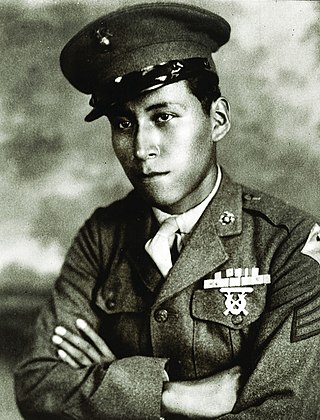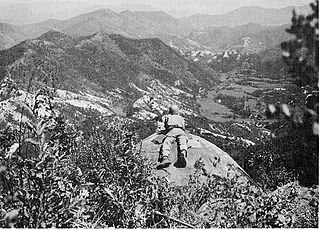Battle of Naktong Bulge refers to several engagements during the Korean War:
- First Battle of Naktong Bulge, August 5–19, 1950
- Second Battle of Naktong Bulge, September 1–15, 1950
Battle of Naktong Bulge refers to several engagements during the Korean War:
Bulge may refer to:

The 1st Provisional Marine Brigade was a marine brigade of the United States Marine Corps (USMC) that existed periodically from 1912 to 1950. It was an ad hoc unit formed for specific operations and not considered a "permanent" USMC unit.

The Battle of the Pusan Perimeter was a large-scale battle between United Nations Command (UN) and North Korean forces lasting from August 4 to September 18, 1950. It was one of the first major engagements of the Korean War. An army of 140,000 UN troops, having been pushed to the brink of defeat, were rallied to make a final stand against the invading Korean People's Army (KPA), 98,000 men strong.

Ernest Richard Kouma was a soldier in the United States Army during World War II and the Korean War. He rose to the rank of master sergeant and received the Medal of Honor for his actions on August 31 and September 1, 1950, during the Second Battle of Naktong Bulge in South Korea.

Mitchell Red Cloud Jr. was a United States Army corporal who was killed in action while serving in the Korean War. Corporal Red Cloud posthumously received the Medal of Honor for heroic actions "above and beyond the call of duty" near Chonghyon, North Korea, on 5 November 1950 during the Chinese First Phase Campaign. Before joining the army, he had been a United States Marine Corps sergeant who had served in World War II.
The 4th Infantry Division was a military formation of the Korean People's Army during the 20th Century.
The 117th Division was a military formation of the People's Volunteer Army during the Korean War with a standard strength of approximately 10,000 men. It was a component of the 39th Army, consisting of the 349th, 350th, and 351st Regiments.
The 124th Division was a division of the PRC People's Liberation Army. During the Korean War, it was the first unit of the People's Republic of China to cross the Yalu River.

Major General Laurence B. "Dutch" Keiser was an American officer who served in both World War I and World War II. During the early stages of the Korean War, he commanded the 2nd Infantry Division.
Nakdong River Victory Memorial Hall, also known as Nakdong River Battle Museum, is a small museum built inside the Apsan Park to commemorate the soldiers and civilians killed during the Korean War at a battle that raged near the Nakdong River. The grounds around the museum are scattered with vintage tanks and airplanes from the Korean War. Built in 1979 the museum has two floors with exhibits from the Korean War and other significant eras in Korea's past. Other areas within the museum pay tribute to those that died in both natural and man-made disasters in Korea's past.
The Battle of the Bulge was a major World War II German offensive in 1944.

The First Battle of Naktong Bulge was an engagement between United Nations Command (UN) and North Korean forces early in the Korean War from August 5–19, 1950 in the vicinity of Yongsan and the Naktong River in South Korea. It was a part of the Battle of Pusan Perimeter, and was one of several large engagements fought simultaneously. The battle ended in a victory for the UN after large numbers of US reinforcements destroyed an attacking North Korean division.

The Battle of Taegu was an engagement between United Nations Command (UN) and North Korean forces early in the Korean War, with fighting continuing from August 5–20, 1950 around the city of Taegu, South Korea. It was a part of the Battle of Pusan Perimeter, and was one of several large engagements fought simultaneously. The battle ended in a victory for the UN after their forces were able to drive off an offensive by Korean People's Army (KPA) divisions attempting to cross the Naktong River and assault the city.

In the Battle of the Bowling Alley , United Nations Command (UN) forces defeated North Korean forces early in the Korean War near the city of Taegu, South Korea. The battle took place in a narrow valley, dubbed the "Bowling Alley", which was north of Taegu. It followed a week of fighting between the Korean People's Army (KPA) 13th Division and the Republic of Korea Army's (ROK) 1st Division along the latter's last defensible line in the hills north of the city. Reinforcements, including the US Army's 27th and 23rd Infantry Regiments were committed to bolster the ROK defenses. This battle and several others were smaller engagements of the Battle of Pusan Perimeter.

The Battle of Nam River was an engagement between the United Nations Command (UN) and North Korean forces early in the Korean War from August 31 to September 19, 1950, in the vicinity of the Nam River and the Naktong River in South Korea. It was a part of the Battle of Pusan Perimeter, and was one of several large engagements fought simultaneously. The battle ended in a victory for the United Nations after United States Army (US) troops repelled a Korean People's Army (KPA). attack across the river.
Lee Kwon-mu, also known as Yi Kwon-mu or Ri Gwon-mu (1914–1986?), was a North Korean People's Army general officer during the Korean War. He commanded a division, and later a corps, on the front line of the conflict and received North Korea's two highest military honours, the Hero of the Republic and the Order of the National Flag, First Class.

The Great Naktong Offensive was a North Korean military offensive against United Nations Command (UN) forces early in the Korean War, taking place from September 1–15, 1950. It was the North Korean Korean People's Army (KPA)'s unsuccessful final bid to break the Pusan Perimeter established by the UN forces.

The Battle of Tabu-dong was an engagement between United Nations Command (UN) and North Korean forces early in the Korean War from 3 to 29 August 1950, in the vicinity of Tabu-dong, north of Taegu in South Korea. It was a part of the Battle of Pusan Perimeter, and was one of several large engagements fought simultaneously. The battle ended in a victory for the UN after large numbers of United States Army (US) and Republic of Korea Army (ROK) troops repelled a strong Korean People's Army (KPA) attack.

The Second Battle of Naktong Bulge was an engagement between United Nations Command (UN) and North Korean forces early in the Korean War from September 1 to September 15, 1950, along the Naktong River in South Korea. It was a part of the Battle of Pusan Perimeter, and was one of several large engagements fought simultaneously. The battle ended in a victory for the United Nations after large numbers of United States Army (US) troops repelled a strong Korean People's Army (KPA) attack.

The Battle of Yongsan was an engagement between United Nations Command (UN) and North Korean forces early in the Korean War from September 1–5, 1950, at Yongsan in South Korea. It was part of the Battle of Pusan Perimeter and was one of several large engagements fought simultaneously. The battle ended in a victory for the UN after large numbers of United States Army (US) repelled a strong Korean People's Army (KPA) attack.